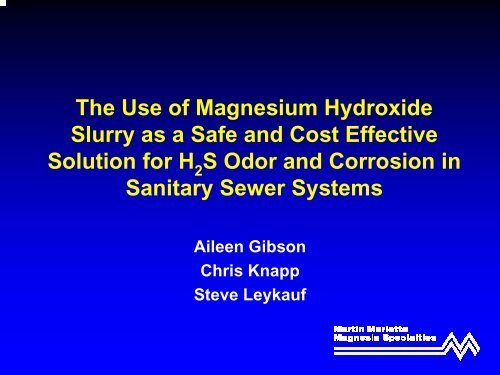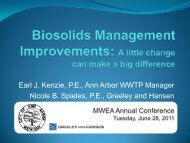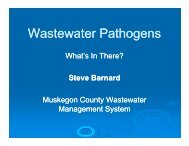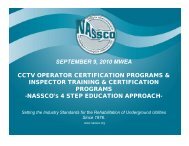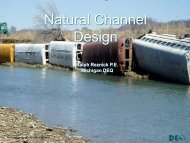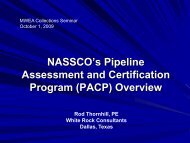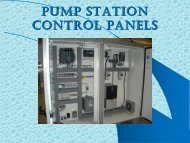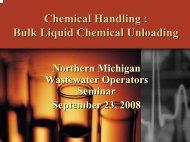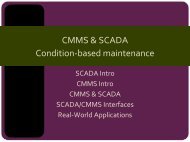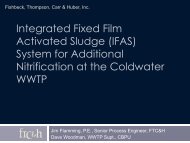Magnesium Hydroxide Slurry: A Safe, Cost Effective Solution for ...
Magnesium Hydroxide Slurry: A Safe, Cost Effective Solution for ...
Magnesium Hydroxide Slurry: A Safe, Cost Effective Solution for ...
You also want an ePaper? Increase the reach of your titles
YUMPU automatically turns print PDFs into web optimized ePapers that Google loves.
The Use of <strong>Magnesium</strong> <strong>Hydroxide</strong><br />
<strong>Slurry</strong> as a <strong>Safe</strong> and <strong>Cost</strong> <strong>Effective</strong><br />
<strong>Solution</strong> <strong>for</strong> H 2<br />
S Odor and Corrosion in<br />
Sanitary Sewer Systems<br />
Aileen Gibson<br />
Chris Knapp<br />
Steve Leykauf
Wastewater Treatment History<br />
• In 1977, the Clean Water Act Increased<br />
Requirements <strong>for</strong> Secondary Treatment<br />
• Categorical Pre-treatment Reduced Heavy Metals<br />
• Shift from Phosphate to Sulfur Based Detergents<br />
• More Centralized Treatment<br />
• Low Flow Plumbing Fixtures
DISSOLVED SULFIDE<br />
CONCENTRATION (mg/l)<br />
Corrosion Effect<br />
20<br />
DISSOLVED SULFIDE VS. TOTAL METALS<br />
15<br />
10<br />
10<br />
5<br />
Sulfides<br />
Metals<br />
Corrosion Threshold<br />
0<br />
0<br />
1980 1985 1990 1995<br />
TOTAL METALS<br />
CONCENTRATION (mg/l)
Effects on Municipalities<br />
• Hydrogen Sulfide (H 2 S) Formation Has Increased<br />
• Accelerated Biogenic Corrosion<br />
• Increased Sewer and Plant Odors<br />
• Grease Buildup (Fats, Oil and Grease – FOG)<br />
• Treatment Plant Upsets<br />
• Higher <strong>Cost</strong> of Treatment
Facts<br />
• U.S. Wastewater Infrastructure is Failing<br />
Faster than it is Being Replaced<br />
• Sanitary Sewer Overflows (SSO’s) are Very<br />
<strong>Cost</strong>ly Fiscally and Politically<br />
• Odor and FOG are Significant Problems<br />
Which Also Carry High Fiscal and Political<br />
Expense
Corrosion Chemistry<br />
• When Dissolved<br />
Oxygen Falls Below 0.1<br />
mg/l, Wastewater Turns<br />
Septic and Anaerobic<br />
• These Bacteria<br />
(SRB) Reduce Sulfate<br />
to Sulfide Producing<br />
the Rotten Egg Smell<br />
Called Sewer Gas<br />
H 2 S Gas H 2 S Gas<br />
D.O.
Corrosion Chemistry<br />
H 2 S<br />
H 2 S<br />
H 2 S Gas<br />
H 2 S<br />
H 2 S Gas H 2 S Gas<br />
SO<br />
2-<br />
4 HS - H 2 S<br />
• Hydrogen Sulfide<br />
Gas is the Principal<br />
Source of Odor and<br />
Corrosion<br />
• Evolution of H 2 S is a<br />
Function of Dissolved<br />
Sulfide Concentration,<br />
Water Temperature,<br />
Turbulence and pH
At pH 7 Roughly 50% of<br />
the Dissolved Sulfide<br />
Can Exist As Hydrogen<br />
Sulfide<br />
H 2 S<br />
H 2 S<br />
H 2 S Gas<br />
H 2 S<br />
H 2 S Gas H 2 S Gas<br />
6.00<br />
1200<br />
H 2 S (aq) and HS - in solution (mg/L)<br />
5.00<br />
4.00<br />
3.00<br />
2.00<br />
1.00<br />
H 2 S (g)<br />
HS -<br />
H 2 S (aq)<br />
1000<br />
800<br />
600<br />
400<br />
200<br />
H2S (g) in air (ppm)<br />
SO<br />
2-<br />
4 HS - H 2 S<br />
0.00<br />
0<br />
3 4 5 6 7 8 9 10<br />
pH
Corrosion Chemistry<br />
• In the Headspace H 2 S<br />
Gas is Biologically<br />
Converted to Strong<br />
Sulfuric Acid by<br />
Thiobacillus Bacteria<br />
• This Results in<br />
Corrosion of Sewage<br />
System Infrastructure<br />
Thiobacillus<br />
Acid Attacks<br />
Concrete<br />
H 2 S + O 2 = H 2 SO 4<br />
SO 4<br />
2-<br />
HS - H 2 S
<strong>Magnesium</strong> <strong>Hydroxide</strong> <strong>Slurry</strong><br />
Properties<br />
Properties<br />
Typical*<br />
Mg(OH) 2 Purity, % (dry basis) 98.8<br />
Median particle size, microns 3<br />
Dry solids, % 61.0<br />
Viscosity, cps 200<br />
pH 10.0<br />
* THIOGUARD ® <strong>Magnesium</strong> <strong>Hydroxide</strong> <strong>Slurry</strong>
How Does <strong>Magnesium</strong> <strong>Hydroxide</strong><br />
• Mg(OH) 2 Raises the<br />
Wastewater pH to 8.0-<br />
8.5<br />
Resulting In:<br />
Reduced Efficiency<br />
of SRB and Less<br />
Sulfide Production<br />
Reduced or<br />
Elimination of H 2 S<br />
Gas Production<br />
Reduced Corrosion<br />
Rate of Sewer Pipes<br />
<strong>Slurry</strong> Work<br />
H 2 S (aq) and HS - in solution (mg/L)<br />
6.00<br />
5.00<br />
4.00<br />
3.00<br />
2.00<br />
1.00<br />
H 2 S (g)<br />
H 2 S (aq)<br />
HS -<br />
0.00<br />
0<br />
3 4 5 6 7 8 9 10<br />
pH<br />
1200<br />
1000<br />
800<br />
600<br />
400<br />
200<br />
H2S (g) in air (ppm)
<strong>Magnesium</strong> <strong>Hydroxide</strong> <strong>Slurry</strong><br />
Benefits<br />
• Prevents Formation of H 2 S Odor & Corrosion in<br />
Municipal Collection Systems<br />
• Extends Life of Sewer System<br />
• Reduces FOG<br />
• Mg(OH) 2 Dosage Is Not Dependent On Sulfide<br />
Concentration
FOG (Fats, Oils & Grease)<br />
Be<strong>for</strong>e Mg(OH) 2 ….
After Mg(OH) 2
<strong>Magnesium</strong> <strong>Hydroxide</strong> <strong>Slurry</strong><br />
Additional Benefits<br />
• Due to pH Buffering Ability of Mg(OH) 2 , Less<br />
Feed Points Are Required<br />
• No Sludge Is Formed As With Iron Salts<br />
• Non-Hazardous and Non-Corrosive<br />
• Improves Downstream Wastewater Treatment<br />
Operations
Biological<br />
Biological<br />
Treatment<br />
Treatment<br />
Secondary<br />
Secondary<br />
Clarifier<br />
Clarifier<br />
Digestion<br />
Digestion<br />
Effluent<br />
Effluent<br />
Conditioning<br />
Dewatering<br />
Conditioning<br />
Conditioning<br />
Dewatering<br />
Dewatering<br />
Primary<br />
Primary<br />
Treatment<br />
Treatment<br />
Collection<br />
Collection<br />
System<br />
System<br />
Disinfection<br />
Disinfection<br />
Biological<br />
Biological<br />
Treatment<br />
Treatment<br />
Primary<br />
Treatment<br />
Conditioning<br />
Dewatering<br />
Biosolids<br />
Conditioning<br />
Conditioning<br />
Dewatering<br />
Dewatering<br />
Biosolids<br />
Biosolids<br />
Digestion<br />
Digestion<br />
Secondary<br />
Secondary<br />
Clarifier<br />
Clarifier<br />
Collection<br />
Collection<br />
System<br />
System<br />
Effluent<br />
Effluent<br />
Disinfection<br />
Disinfection<br />
Total System Treatment<br />
Benefits<br />
Mg(OH) 2<br />
<strong>Slurry</strong>
Case Study: Canton, OH<br />
• Using Mg(OH) 2 at Stark County (Canton, OH)<br />
–High H 2 S at Plum Street Manhole in Waynesburg, OH<br />
– Inject 2 Miles Upstream in Magnolia Wetwell<br />
Injected Tg<br />
H 2 S Reduction<br />
Lowered<br />
Feed Rate
Case Study: Summit County, OH<br />
Begin Tg Feed<br />
Intentionally Terminate Tg Feed
Case Study: Akron, OH<br />
Started feeding<br />
Thioguard at 2:15pm<br />
4-18-06<br />
Start Seeing Effects<br />
of Thioguard<br />
Addition
Case Study: Lagrange, IN<br />
350<br />
300<br />
Injected Tg<br />
Hourly Average<br />
Hourly Maximum<br />
250<br />
H2S PPM at LS #6<br />
200<br />
150<br />
Terminated Tg<br />
100<br />
50<br />
0<br />
5/14/07 0:00 5/16/07 0:00 5/18/07 0:00 5/20/07 0:00 5/22/07 0:00 5/24/07 0:00 5/26/07 0:00
Case Study: Steuben Lakes, IN<br />
80<br />
70<br />
THIOGUARD<br />
Feed Starts<br />
H2S PPM<br />
60<br />
50<br />
40<br />
Start Seeing<br />
THIOGUARD<br />
Effects Here<br />
Hourly Maximum<br />
Hourly Average<br />
30<br />
20<br />
10<br />
0<br />
2/27/2007 2/28/2007 2/28/2007 3/1/2007 3/1/2007 3/2/2007 3/2/2007 3/3/2007 3/3/2007 3/4/2007 3/4/2007 3/5/2007
Mg(OH) 2 <strong>Slurry</strong> Handling<br />
• <strong>Slurry</strong> Requires Periodic Agitation to Keep<br />
Solids in Suspension<br />
• Maintain Minimum Line Velocity Through<br />
Feed Lines<br />
• Recommend Peristaltic or Progressive Cavity<br />
Pumps <strong>for</strong> Metering<br />
• With 0 o C Freezing Point, Need Freeze<br />
Protection On Equipment
Mg(OH) 2 <strong>Slurry</strong> Equipment<br />
• Bulk Storage and Feed System<br />
– 2500-Gallon Tank<br />
With Heat Pads<br />
– Peristaltic Feed<br />
With VFD<br />
– Control Panel<br />
With Power and<br />
Control Signal<br />
Connections
Mg(OH) 2 <strong>Slurry</strong> Equipment<br />
• Tote Storage and Feed<br />
System<br />
• Agitator<br />
• 275-Gallon Day Tank<br />
• Control Panel<br />
• Flow Meter<br />
• Air-Driven Transfer<br />
Pump<br />
• Progressive Cavity Feed<br />
Pump
Compared To Other Treatment Options<br />
<strong>Magnesium</strong> <strong>Hydroxide</strong> <strong>Slurry</strong> Is…<br />
• Less Expensive, Particularly At High Sulfide<br />
Concentrations<br />
• More <strong>Effective</strong> For Odor and Corrosion Control<br />
• Non-Hazardous and Non-Corrosive<br />
• Can be Used System-Wide<br />
• Solves More Problems
Thank You.<br />
Any Questions


